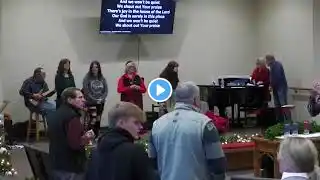
12 10 2023 Advent 2 Pastor Scott Bennett
Advent (2) Peace (12-10-23) What Does the Second Week of Advent Candle Stand For? The first advent candle (“The Prophets Candle”) is purple and represents hope. The second advent candle (“The Bethlehem Candle”) is also purple and represents peace. Peace is a central theme of the Advent season but the main focus of the second week of Advent. One of the prophecies about Jesus calls Him “the Prince of Peace” (Isaiah 9:6-7). What Does Peace Really Mean? Peace is one of those words that people often use but they don’t always explain it very well. Depending on which religion or philosophy that people follow, their definitions of peace may vary greatly. In some Eastern religions, finding serenity or inner peace means believing that everything dies; all is nothing. It’s important as Christians to understand how the Bible describes peace. In Hebrew, the word peace is shalom. Throughout the Bible, shalom is used in several ways. Physically well God’s protection and blessing At peace with each other. Humanity lost peace with God when sin entered the world. From the moment that Adam and Eve ate the forbidden fruit in the Garden of Eden, all of humanity became sinners (2 John 1:8). This put us in conflict with God. The “flesh,” in the sense of sinful desires, became what we follow (Romans 8:7-8). No human being, since Adam and Eve, has been righteous (Ecclesiastes 7:20), which means that we are all in a state of rebellion against Him. How Does Jesus Bring Peace? Jesus talked about peace on several occasions. Blessed are the peacemakers (Matthew 5:9). He warned His disciples that He had not come to bring peace to the world, that in fact, He would divide people (Matthew 10:34-36). Christ ultimately came to earth to bring peace, but when people choose to follow Jesus, they will often face division and conflict, even within their own households. To choose loyalty to family over loyalty to Christ disqualifies a person from being one of His disciples (Luke 14:25-27). He told His disciples that He would leave them and comforted them with these words (John 14:27). Peace in the Storm (Matthew 8:23-27). Mark’s wording suggests the silencing of a demon. That the sea obeyed Him-turning immediately calm-proves that Jesus has power over the elements of nature as well as the principalities and demonic forces. Our God is the Supreme Ruler! “Peace, be still.” Jesus has the power to bring peace into the storms of life. “Glory to God in the highest” (Luke 2:8-14). When Jesus was Born in Bethlehem, deity invaded humanity, eternity invaded time, and royalty invaded poverty. God chose the least of all the cities (Bethlehem) to host the birth of His Son, and He chose the least of all society (shepherds) as the first witnesses. The shekinah glory of the Lord appeared for the first time in centuries in, of all places, an open field populated by shepherds. “Do not be afraid,” was a message that had been anxiously awaited for the nation of Israel had been without a word from the Lord for over 400 years. Jesus was born at a time when a message of great joy was desperately needed. Peace With God. Jesus “The Prince of Peace” came to make peace between humanity and man. He came to pay the price that humanity could not pay. He became the sacrificial lamb that paid the price for humanities sins once and for all (Hebrews 9:12). Therefore, everyone who believes in Jesus divinity and resurrection (Romans 10:9-10), achieves peace with God. Are you at peace with God? Through Him, and only Him, you can be at peace with God. Jesus said, “I am the way, the truth, and the life. No one comes to the Father except through Me. (John 14:6). Advent is all about “Peace.” Are you at peace? With each other (Mark 9:50) With yourselves (1 Thessalonians 5:13) With God (Colossians 3:15)

